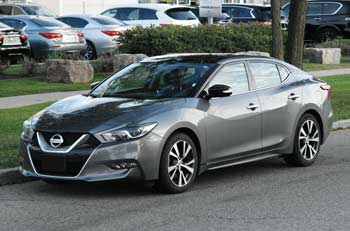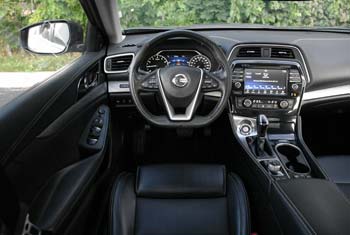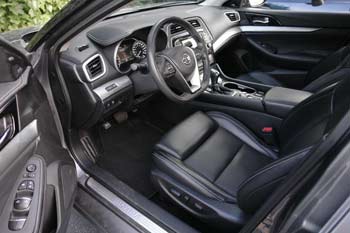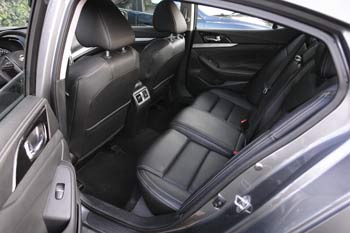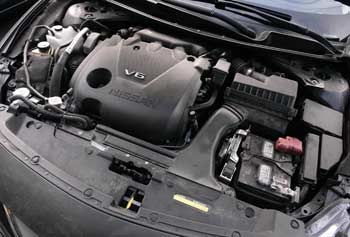Nissan Maxima 2016-2023: pros and cons, common problems
By Vlad Samarin, Updated: February 04, 2024
There are full-size sedans on the road that are just boring. The Nissan Maxima isn't one of them, and that's not just talking about its energetic looks. The Maxima gives off a fierce growl with its proven VQ35DE 300-HP 3.5L V6 engine as you put your foot down in Sport Mode.
The Continuously Variable Transmission (CVT) also makes the Maxima one of the best in its class for fuel economy. The interior is beautiful and the supportive seats add to the sporty feel.
Pros:
- Sporty Design: The Nissan Maxima offers a sporty and distinctive design, standing out in its class.
- Proven and Powerful V6: With a potent V6 engine, the Maxima delivers strong and smooth driving experience. It's also one of the best V6 engines on the market.
- Well-Appointed Interior: The Maxima features a premium interior with quality materials and modern design.
- Advanced Safety Features: Many models come equipped with advanced safety features, contributing to a safer driving experience.
- Good Traction: The heavy V6 engine adds extra weight on front drive wheels which improves traction.
Cons:
- Reduced Rear Visibility: The design of the Maxima leads to reduced rear visibility, especially when parking.
- Price: Compared to some competitors, the Maxima comes with a higher starting price.
- Not Available with AWD: The Maxima is offered with front-wheel drive only.
- Firm Ride: The sporty suspension setup results in a firmer ride.
- CVT transmission: Not only the CVT transmission has a question reputation for reliability, it will be expensive to replace if it fails.
- Interior Space: While the Maxima offers a comfortable interior, some may find that the rear seat space is a bit more limited compared to larger sedans.
- Depreciation: At higher mileage, the Maxima will not hold its value as well as some other cars.
Broken anti-rattle clips in the moonroof may cause a rattle when driving with it open, or when opening or closing it, according to Technical Service Bulletin NTB19-059a. The part will need to be replaced. Moonroof repairs can be costly, check your warranty coverage. You can find the Warranty Information Booklet for your Maxima here.
Owners have reported the trim/moulding at the rear roof pillar falling off, particularly in car washes or extreme weather. The fix for this cosmetic damage is about a couple hundred dollars, see this thread for more details including part numbers.
According to Technical Service Bulletin NTB15-099b for the 2016 Maxima, a damaged or misaligned sensor bracket or obstruction (among other causes) may cause the front radar sensor not to work, producing the codes C1A16 or C1A12. According to some owners, this can prevent the Forward Emergency Braking system (available in higher Maxima trims) from working, displaying a malfunction message on the dash. If the bracket is bad, it will need to be repaired or replaced and the sensor alignment will need to be performed. There may also be something such as dirt, debris, scrapes or punctures blocking the bumper fascia in front of the sensor. You can check out this video for more details on the system, as well as your Owner's Manual. According to this thread, even if the layer of paint on the bumper is too thick, it can also cause the sensor not to work. Since the sensor is fairly low to the ground behind the front bumper cover, park carefully as an impact with a curb can damage the sensor.
A bad O2 sensor (Air fuel ratio sensor) may cause the trouble codes P0158, P0037 or P0057. The part will need to be replaced, costing from $340 to $540 parts and labor.
A loose or bad gas cap may cause the codes P0456, P0455, or P0442. According to Technical Service Bulletin NTB13-097h, if you get the "Loose Fuel Filler Cap" message, make sure that the fuel filler cap is installed correctly. If the cap appears okay and the message has not gone away after some driving, the EVAP system will need to be diagnosed by a technician. The Technical Service Bulletin NTB17-082b on the NHTSA website states that the code P0456 can also be caused by an EVAP leak at the vent control valve O-ring. If this is the case, the O-ring is not expensive and is fairly easy to replace.
Some owners have reported issues with the CVT transmission. According to Technical Service Bulletin TSB NTB17-039L and its amendments, a problem with the CVT transmission in the 2016-2019 Maxima can cause shaking, juddering and vibration, along with diagnostic codes P17F0 or P17F1. Following diagnosis, the CVT may need a new valve body and the sub assembly may also need to be replaced if the CVT chain does not check out OK per the TSB. The TCM may also need to be reprogrammed. According to Nissan USA, the XTRONIC CVT is covered by a 5 year/60,000 mile (whichever comes first) powertrain warranty. Check for warranty extensions, as rebuilding or replacing the transmission out of warranty is an expensive repair.
Check for any recalls on the NHTSA website.
Summary
The 2016-2023 Maxima is a good premium full-size sedan. It has a very good V6 engine and a nicely done interior with many luxury features. It's one of the cars that you will feel solid and secure driving. The CVT transmission is better than in some other Nissan models, but is still a potential weak spot. If you are buying this car, consider an extended warranty for the powertrain with no limit per claim. Check out or reviews of similar cars:2014-2021 Mazda 6
2013-2017 Honda Accord
2015-2017 Chrysler 200
2012-2017 Toyota Camry
Does the engine come with a timing belt or chain? The Nissan Maxima comes with a maintenance-free timing chain. The chain is located inside the engine and is lubricated by engine oil. To keep it in good condition, make sure to change your oil regularly and top it up when needed.
Engine: The dependable VQ35DE comes standard on all Maximas. Although Nissan has stated that the engine uses 60% new parts compared to the previous generation, the VQ35DE is a tried and tested engine that has been used for decades in Nissan as well as Infiniti models. Nissan recommends using premium gasoline with an octane rating of at least 91. You can also use unleaded regular gas with an octane rating of at least 87 but may see a decrease in performance, according to the Owner's Manual.
How does the CVT transmission work? Instead of using fixed gears, the CVT uses 2 pulleys linked by a chain. These pulleys change in size as you drive to continuously vary the gear ratio. This allows the Maxima to get good gas mileage despite having a lively V6 engine. During spirited driving, Nissan's XTRONIC CVT mimics gear shifting for a sporty feel. See these Nissan Global and Nissan USA posts describing how the CVT works with diagrams. Read also: Pros and cons of the CVT transmission.
Fuel Economy: According to the EPA, 2016 Nissan Maxima gets 22/30 MPG City/Highway, getting 450 miles/724 km on one tank. The 2017-2018 Maxima is rated at 21/30 MPG City/Highway, also getting up to 450 miles/724 km to a tank. The 2019-2021 Nissan Maxima scores 20/30 MPG City/Highway, getting 432 miles/695 km on one tank.
Safety: According to the NHTSA crash tests, the 2016-2017 and 2020-2021 Maxima scored 5 stars overall for frontal, side impact and rollover. The 2018 Maxima scored 4 stars for the frontal crash test and 5 stars for side impact and rollover. The 2019 Maxima is only rated for rollover, scoring 5 stars.
What to look for when buying a used Nissan Maxima: When buying a used Maxima, the key is to pay close attention to the CVT. On your test drive, be on the lookout for any shaking, juddering, or other transmission quirks that make your drive not smooth. Avoid the vehicle if any of these symptoms are present. Check the moonroof; does it make any rattles when opening/closing or while you drive with it open? Are there any warnings present on the dash such as a sensor malfunction or the Check Engine light staying on? Before buying, have the car inspected on a lift by an independent mechanic.
